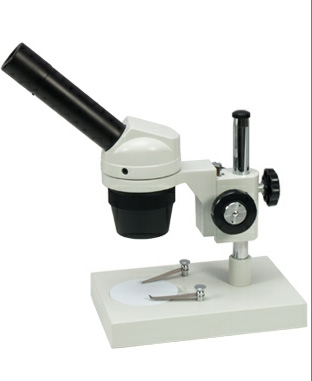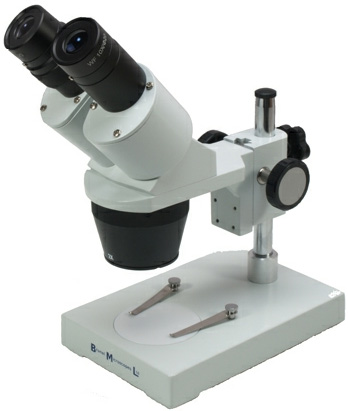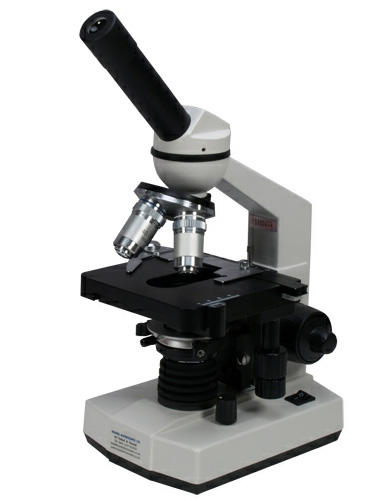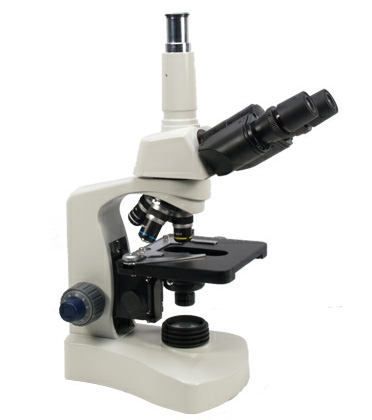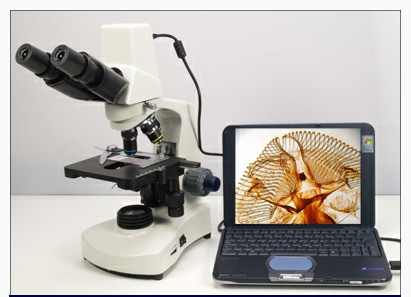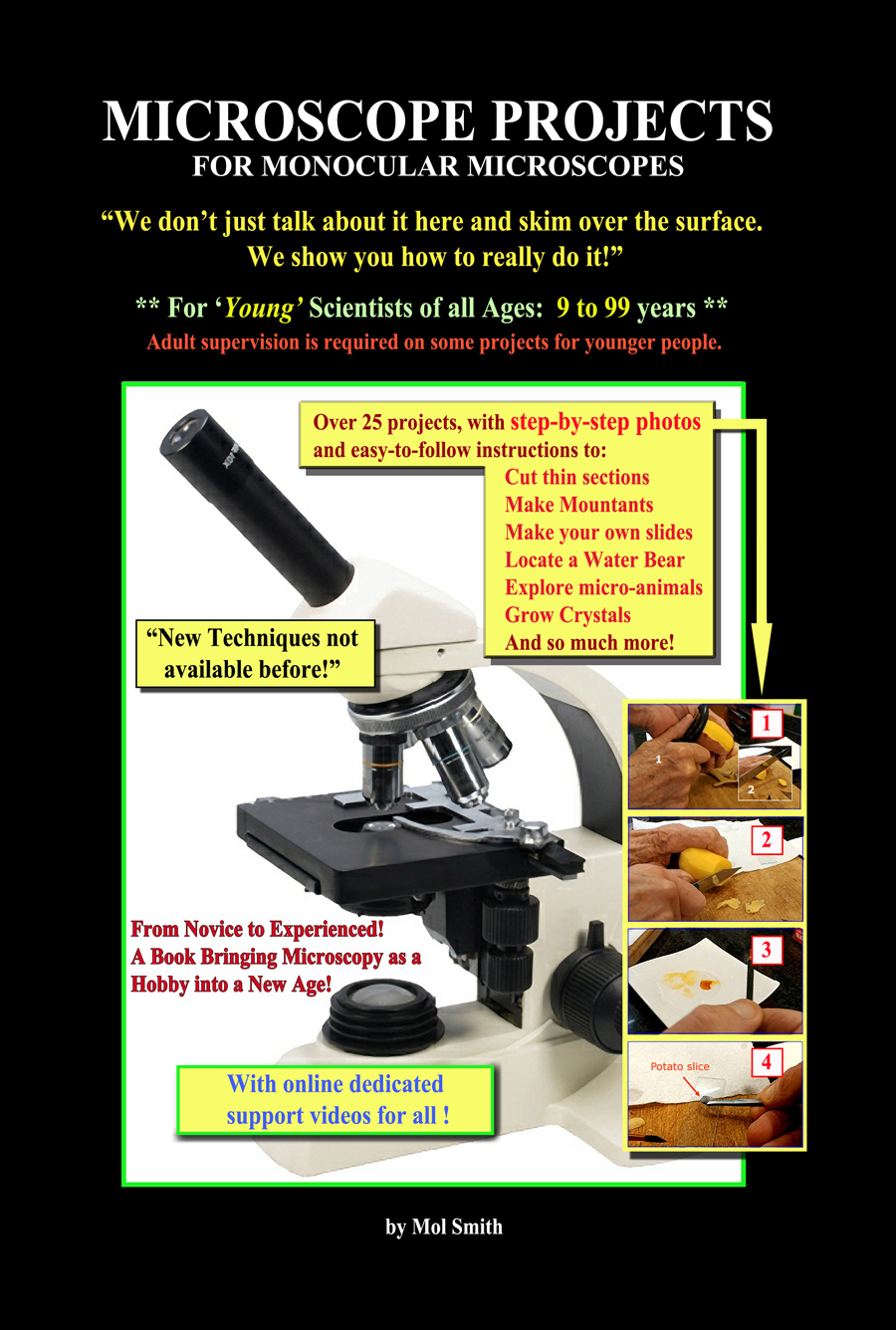Microscopy As A Hobby
by Mol Smith (UK).
Part 1: Choosing A Microscope.
(Oct. 2020)
"On the run up to Christmas again, which made me want to warn folks."
There are many books and multiple resources now on the Internet centred on practicing microscopy as a hobby or past-time. Most people aged 25 to 55 years are too busy working with little spare time these days for a hobby, so the pursuit mostly attracts children, or older people coming up to retirement or who are already retired. There are, of course, many exceptions to this insight of mine. This article is designed to give you a general
idea if you wish to consider it as a worthwhile hobby for you or perhaps interest a child. Microscopy means the use of a microscope to study objects, processes, and subjects with either a low or high power microscope. I think the subject should also include the study of the same with a hand lens or by a using macro-photography camera. They also give you a closer view and offer a better understanding of the world around you and the things in it. I tend to focus most of my various books and articles on people
starting up the hobby, but one can pick different levels of expertise and learning, from just simple techniques right up to difficult and complex ones. This article addresses the former. Getting started .
Several ways of starting.
The first thing is do not to go to Amazon looking to buy a microscope without reading this article first. I can't stress
this enough! Amazon sellers, whilst many are sincere bona-fide merchants, many are not, and their offers, which often seem to too good to be true, are exactly that: not true! They are traps and snares to sell you rubbish and make it difficult
for you to get your hard-earned cash back. So learn from me first, please!
WHAT NOT TO BUY
CHILDREN
Microscopes for different kinds of studies (and different age groups)
Maybe you are a parent looking buying a microscope for a young child as a present. Christmas, birthday, a reward? You must choose according to the age of your child. Many TOY microscopes are offered at very good prices. Don't buy one! Let
me explain why. If you are buying for yourself or a teenager, or another adult, you can skip past this section.
The type of microscopes NOT to buy:
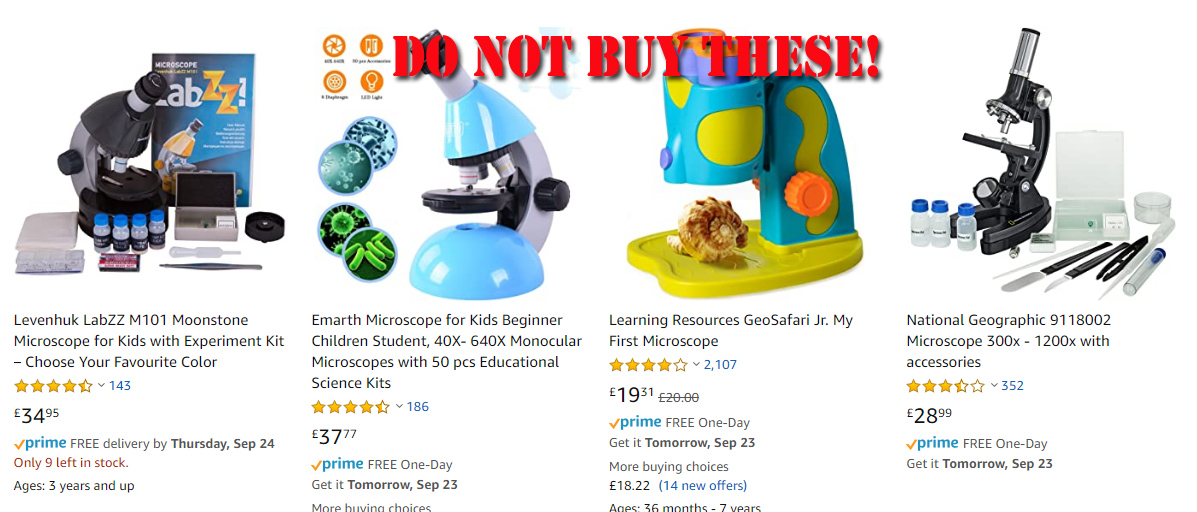
Ignore names connected with recognised education institutes and establishments. Most of them have nothing to do with those quality resources of information. From left to right: 1st one- it's plastic, the body, plastic lenses, no illumination. 2nd one-cheap, plastic, plastic lenses, plastic slides as part of so called science kit. 3rd one-a glorified magnifying glass. A magnifying glass would be more useful and cheaper! The last one is the worst of the lot! This will not focus properly, is made of plastic with plastic lenses, and that National Geographic name is a disgrace! An outright legal scam waiting to take your money! Let me show you more you should not get, so you get the idea.
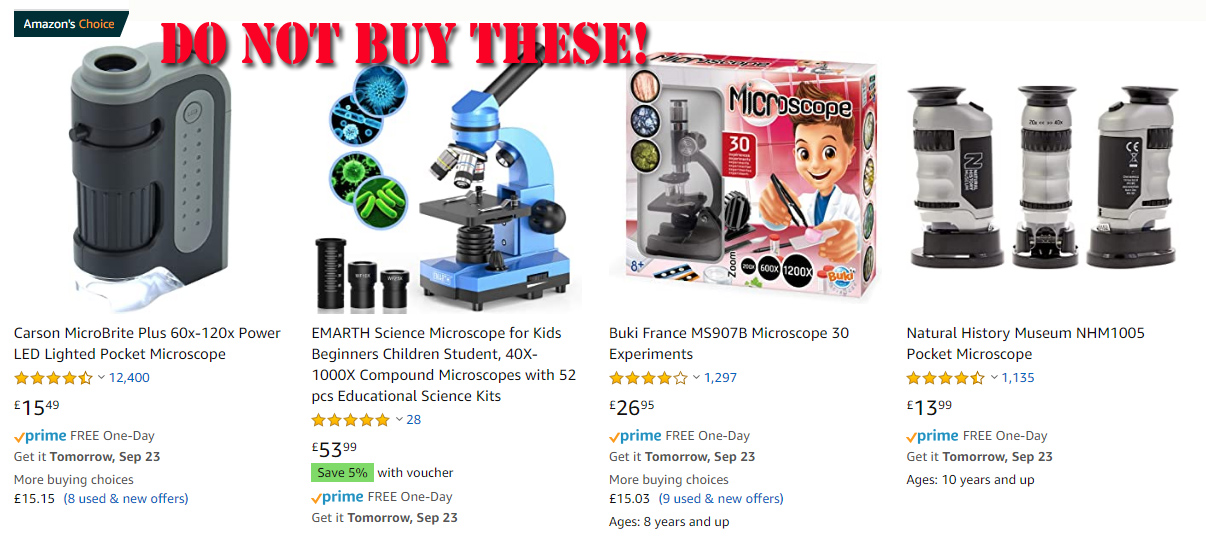
The first from the left and the one on the far right are similar. I'll tell you about these in a moment. The second one is £53.00. It even has metal objective lenses. Big deal! What is does not mention is that is has plastic lenses. Hopeless for any refined study. Plastic lenses distort images and prevent resolution and detail. But the main thing is that a microscope of this type is the wrong type for any child under 11 years of
age, even if it did work well, which it won't. Don't believe positive reviews on Amazon. Many are fake and paid for to help sell a product. I kid you not! The third one has a pretty box. We all fall for it, don't we? Other than that, a complete waste of money: plastic lenses, small field of view... the list is endless. THE LAST OF THESE, I find a crying shame that the National History Museum has put its name to. It is no different to the cheap mass produced plastic one to the far left. Plastic lenses, unresolved
focusing, narrow field of view, and poor details. A glass magnify (a loupe) would give a clearer and higher quality image!
A young child will not wish to see things magnified much more than 10x, 20, or 40x. They just wont be able to understand what they are looking at. When you go above these levels of magnification, you need two focus controls: a rough focus, and a fine focus. If you merely have a single right focus, you will never obtain a sharp image! A microscope uses light and lenses in such a way that the light is stretched out carefully
using GLASS LENSES, to show details between different details of the object. Only glass, high quality, specially ground and coated glass can do the job properly. So, a child wants to own a microscope with good quality glass lenses, sturdy (metal) and with lenses which give a wide field of view. All the cheap microscopes above
will not give a wide field of view. Let me show you:-
The cost of lenses: glass versus plastic, and field of view
The lowest cost of a brand new quality microscopy which will fulfill its promise, will work out of the box, and last for many years, for either a child or an adult will be around £60.00 - £70.00 - at the time of writing. This is the absolute lowest price. If you cannot afford that, do not go buying a cheaper one which will fail to delight you or your child. Instead, look for a used one. Yes, second-hand. They last for many years and older instruments were
made better than ones made today! The reason microscopes below this kind of money are hopeless comes primarily down to the cost of manufacturing lenses of sufficient quality to enable magnification and resolution. One can magnify a thing but you don't see any more detail. Like this fly. Only the first image was an image captured by a macroscopic camera lens. The other two, I just 'blew-up'. This is not what shifting to higher power quality glass lenses do. The divide the rays of light to carry more detail. Cheap
microscopes with bad optical glass lenses, and cheap microscopes with plastic lenses, cannot give better resolved or finer detail. They just do this (below). The same is true of digital microscopes having just one objective lens (the bottom lens).



The manufacture of good quality glass lenses is more expensive by several orders than banging out cheap plastic ones. Good microscopes must obviously cost more than useless ones, no? The next thing then is the fact that some cheaper microscopes DO HAVE GLASS LENSES. But then how can they be cheaper to buy, other than the fact they are probably made of plastic bodies (distortion even at room temperatures), and easier to break? What they do is make a smaller lens. This results in a very limited width of view (field-of-view). Let me show you:
|
Both images left and right are taken of a Bee's leg with a low power magnification under two different microscopes. The microscope on the left has good quality glass lenses of a type designed to give a good field-of-view. |
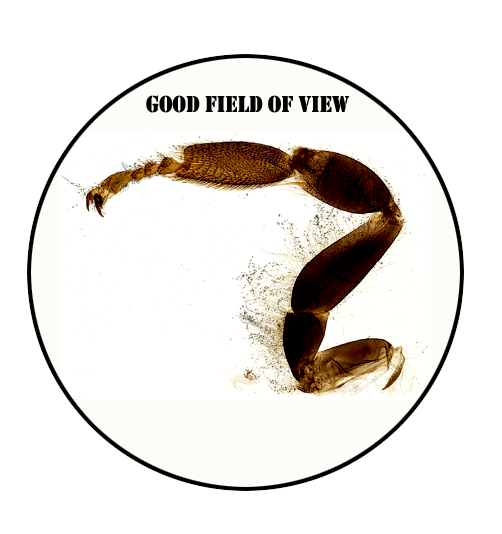 |
 |
WHAT TO BUY
CHILDREN
Young Child
What to buy for a child depends on the age of the child. The younger he/she is, the less complicated the microscope should be. Most very young children will not understand many of the microscope slides containing thin sections of plants or once-living animals and insect parts. They will be more interested in looking at insects or common household items, now they can see them in a novel way by being magnified.
Older Child or Adult Wanting A Budget Entry Level Compound Microscope
A child coming up to his/her teenage years would benefit from a more sophisticated and more powerful instrument, a microscope the growing child can also use during his/her teenage years. A compound microscope is best. Optical Microscopes use light to illuminate a subject. The light has to be strong and focused into a narrow cone. Passing the light through a tiny hole before it shines up beneath a specimen, helps to remove rays in the light at the edge of the
cone. The remaining rays (waves) are then more coherent which improves sharpness in the observed image. The use of a condenser to focus the light and an iris aperture to create a hole of varying diameter are the preferred methods.
|
The microscope on the left is a perfect starter microscope. It has lights above and a dimmable one below the stage. It has an aperture wheel where different size holes are selected. With a metal body, it comes with a widefield 10x optical glass eyepiece and x4, x10, x40 optical glass objectives giving the microscope a range of 40x to 400x magnification. Perfect for most samples and specimens. An accessory eyepiece of x25 can extend the range to 1000x. At a price of between £75-£85 plus VAT, it is an absolute bargain. |
If you can afford a bit extra, this one on the left has extras which improve it greatly: an iris aperture and condenser below stage enabling better contract in the image seen, and a moveable stage which enables better observation of moving subjects like small motile animals in pond water, say. It does not have a light above the stage but one can always use a torch. Most times this type of microscope used specimens lit from beneath and it has a dimmable light for this. It also has an additional objective lens, a x100. This one costs between £100 - £110 plus VAT. I use this for my book projects and recommend it. |
|
Many people using a microscope like to take pictures or videos of what they see. Adaptors exit to enable SLR cameras to be attached to the tube where the eyepiece goes to accomplish that. Also, purpose built digital cameras can be purchased and inserted into the tube. To enable observation and the ability to record an image or video, without stopping observation, trinocular microscopes are made. The one on the left is a good low price microscope of that type. This typically will cost between £350-£360 pounds plus VAT. |
These types of trinocular microscopes are now produced with a variation which means they already have a digital camera built-in. This is located where the third eyetube would go. A computer monitor is required to see the image or video captured. The microscope on the left here has the same specs has the one on the far left but is a good example of that model with the built-in camera. This model costs typically between £430-£450 pounds plus VAT. |
All the microscopes mentioned are suitable for hobby microscopists. Hobbyists often find looking at microscopic life forms in freshwater or ponds to be one of the more fascinating aspects of the hobby. The number of forms are endless. Rarely, do you need to observe them at powers of magnification above 800x and must of the time, observation at 400x and less is best and common. Some people use a microscope to help them with another mainstream hobby. Bee keepers, for example, wanting to use a microscope to help maintain healthy bees should purchase a low power stereo microscope. Fish keepers and bird keepers would benefit more by purchasing a high power compound microscope. All the quality microscopes shown above can be purchased in the UK from Brunel Microscopes Ltd. Click on the image to visit their web page describing the microscope in detail. Similar instruments of similar quality can be purchased by Microscope sellers in the country you reside in, which is the best thing to do to keep shipping costs down.
|
BUY CHEAPER |
||
|
Another way to acquire a quality microscope cheaper is to purchase a second hand one. Many tens of thousands of microscopes have been discarded by medical and educational institutions over the decades. Most of thee microscopes will be in perfect working order. Also, the craftsmanship of lens making was of a higher quality than the mass production methods used today. |
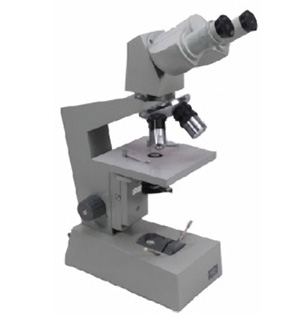 |
This microscope is a good example of a refurbished good quality microscope. It is a Carl Zeiss Jena Binocular, and has objectives lenses x100 Hi with iris diaphragm (1.25), x40 (0.65) and x10 (0.25) with x10 wide field eyepieces that are suitable for spectacle wearers. Kohler illumination with brightness control, quartz halogen lamp.
Coaxial coarse and fine focus control. Stage slide clips. Binocular head with a CCTV adapter. It costs just £270 pounds plus VAT. |
Comments to the author are welcomed.
Microscopy UK Front Page
Micscape Magazine
Article Library
© Microscopy UK or their contributors.
Published in the October 2020 edition of Micscape.
Please report any Web problems or offer general comments to the Micscape Editor
Micscape is the on-line monthly magazine of the Microscopy UK web site at Microscopy-UK
©
Onview.net Ltd, Microscopy-UK, and all contributors 1995
onwards. All rights reserved.
Main site is at
www.microscopy-uk.org.uk.
